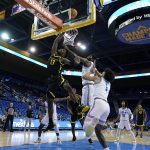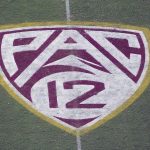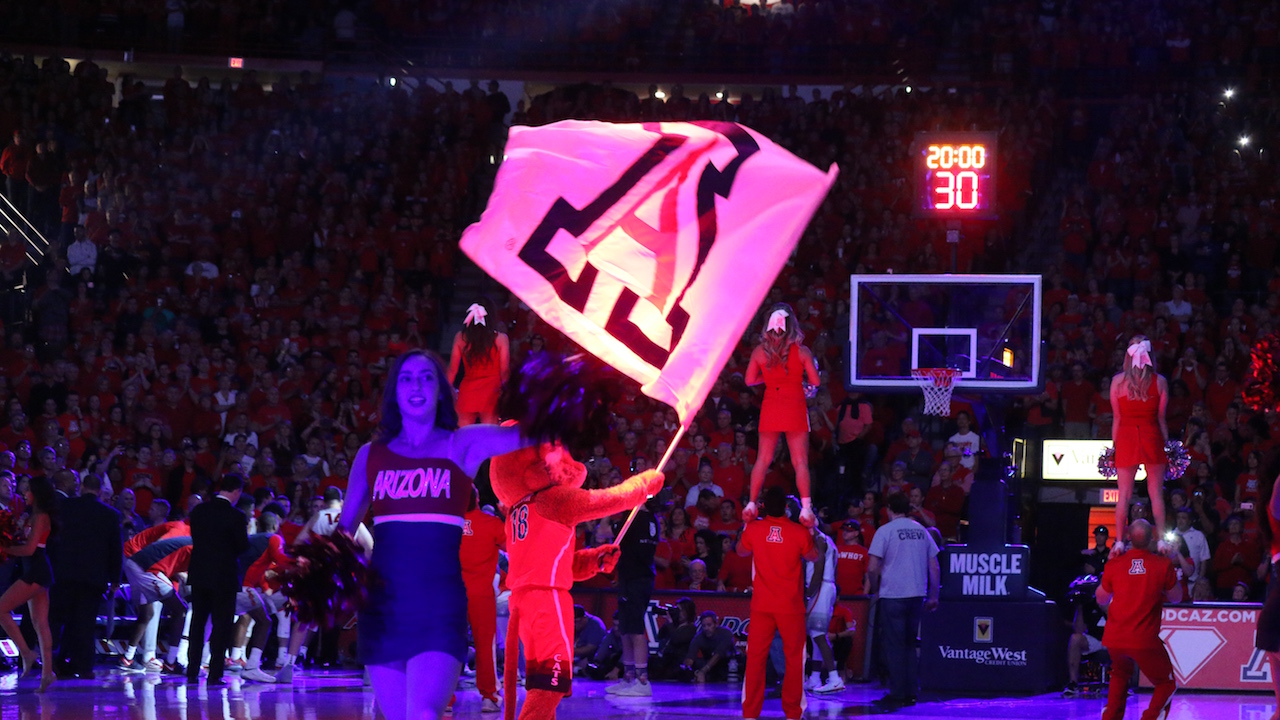Send questions to pac12hotline@
Please note: Some questions have been edited for clarity and brevity.
On the House vs. NCAA case: While I have little doubt the richest schools can afford to pay $46 million, what about smaller Power Five programs like Wake Forest or Washington State? Could this cause them to shut down sports, even football, and have athletic departments go bankrupt? — @DavidJBrown19
Great question because there’s so much ground to cover with this topic.
Let’s start our response in Tucson, where Arizona president Robert Robbins recently told the faculty that ‘draconian’ budget cuts were coming because of financial challenges rooted in a $240 million accounting mistake.
The school has 97 days of cash on hand, instead of 156. (It’s the kind of whopper you’d expect from the Pac-12.)
Arizona’s athletic department has contributed to the crisis, failing to reimburse the university “fast enough” for a $55 million COVID-era loan, Robbins said.
Eliminating sports programs is a strong possibility.
“Everything is on the table in terms of dealing with athletics,” Robbins said.
It’s a deeply unfortunate situation for the campus and a local economy that depends so strongly on the university. But our focus here is the athletic piece, and in that regard, the Wildcats bear a distinct resemblance to the canary in the coal mine.
This brings us to the House vs. NCAA case that you cited, and the Hotline addressed earlier this week.
Those unfamiliar should know the antitrust lawsuit, named for former Arizona State swimmer Grant House, is a game-changer on steroids for the NCAA.
The plaintiffs are seeking compensation related to name, image and likeness for more than 10,000 athletes over a five year period before NIL was legalized by the NCAA in the summer of 2021.
The suit claims media rights revenue should be part of the NIL compensation.
And it names the Power Five conferences as defendants.
And it was given class-action status by the judge.
Add it up, and the NCAA could be on the hook for $4.2 billion in damages.
Even if there’s a settlement before the trial (in Jan. 2025), the financial impact will be mammoth.
There’s a real chance every Power Five school gets slapped with an NIL bill for tens of millions of dollars and must compensate athletes for media rights deals in the future. (The $46 million price tag cited above is based on our very rough math.)
Expert witnesses for the plaintiffs believe athlete NIL accounts for 10 percent of the value of major conference media deals. If the NCAA loses in court or is forced to settle, the House case likely will lead to a revenue-sharing agreement between the schools and the athletes.
How does this relate to Arizona?
Because there aren’t many athletic departments that can afford to pay tens of millions in NIL back-pay and funnel 10 percent of real-time media rights cash to the athletes.
If Arizona cuts sports because of the current financial crisis, the Wildcats could very well have company in the near future due to the House case.
The potential impact of House — some believe it’s likely; others think it’s inevitable — is almost indescribable, according to a Hotline source who’s well-versed in the consequences.
It will force athletic departments to drastically change their financial models and downsize their scope.
Football will survive, of course. So will men’s and women’s basketball and a few other sports.
But based on our conversations with sources throughout the industry, numerous money-losing Olympic sports programs would be in jeopardy across Division I.
And if House sparks the crisis we anticipate, it will push the top football schools to seek additional cash and more efficient financial models.
In other words: Consolidation.
The media rights cash isn’t necessarily fixed through the rest of the decade and into the early 2030s, but the available amount won’t match the need for income to offset any revenue-sharing arrangement with athletes.
The mini-NFL model that the Hotline and others have envisioned for the sport in the mid- or late-2030s could arrive much sooner if the NCAA, as expected, gets bludgeoned in the House case.
Where Arizona’s athletic department is headed soon, the rest of college sports will follow just a bit later.
It’s getting awfully close to Nov. 14th. What are the odds that there’s a mediated settlement reached before the preliminary injunction hearing in the lawsuit filed by Washington State and Oregon State? — @AmbitiousCoug
A mediated settlement before the preliminary injunction hearing on Nov. 14 is unlikely but perhaps not out of the question, so something like 3-to-1 (or 25 percent implied probability).
The plaintiffs, WSU and OSU, need clarity in order to chart their future before the transfer portal opens in early December. (They definitely do not want a lengthy trial.)
Meanwhile, the 10 departing schools don’t want WSU and OSU to gain full board control over current revenue. (They don’t want a trial, either, in part because of what could be disclosed in the discovery process.)
But neither side wants to relinquish leverage before it’s absolutely necessary.
Our hunch — and it’s nothing more than that — is that both sides gauge Whitman County Superior Court Judge Gary Libey’s tone during the hearing on Tuesday afternoon.
Perhaps they ask for a pause before he rules, then return to mediation and hammer out an agreement.
With no clear plan for WSU and OSU and the transfer portal looming, how are their rosters not going to be raided by teams in Power Five conferences? — @dji0578
If the schools are unable to communicate a path forward (in terms of conference affiliation and competitive resources) to their players, the rosters could be picked apart.
It’s a very real concern.
Then again, their rosters might have been picked apart anyhow, given the modest NIL wherewithal on both campuses (WSU less so than OSU).
Don’t most schools lose out on conference revenue when they announce their departures for another conference? What is the norm across college football? — @PeterErlendson
It depends on the contract situation.
Yes, schools are often forced to pay departure fees, but the Pac-12 never bothered to include an exit penalty in its bylaws (because the presidents, ever arrogant, didn’t think anyone would leave).
And yes, outbound schools can be docked revenue distributions, but only if they leave before the grant-of-rights agreement expires.
None of the Pac-12’s schools are leaving early, so there is no revenue reduction … unless WSU and OSU are given control of the board and decide to withhold payments to the outbound 10.
For the past 11 years, you’ve reminded fans that no team has ever made it through conference play undefeated in the Pac-12 era. Do you think that holds true this year, or does Washington make it? — @keithdennis
The Huskies are three games from the first undefeated record in league play since Oregon in 2010 — before the expansion era.
They play Utah at home, Oregon State on the road and Washington State at home.
We don’t foresee a loss in the Apple Cup, so it’s effectively a two-game season.
Their prospects are excellent.
What do you think of Troy Taylor’s work at Stanford so far? Seems like the Cardinal has exceeded expectations. — @helixcardinal
Taylor has done first-rate work this season. Based on personnel, Stanford should not have two conference wins and should not have pushed Arizona and Washington to the brink.
The Hotline is optimistic about the trajectory of the program under Taylor if the university provides some accommodations with the transfer portal.
Stanford’s roster-building process must lean heavily into high school recruiting, but it needs some flexibility with the portal.
And we aren’t convinced that will happen.
If ESPN’s ‘College GameDay’ comes to Corvallis for the Oregon State-Washington matchup and the ratings are high and the Beavers win, will that change the narrative for the ‘Pac-2’ — and perhaps be a catalyst for ACC or Big 12 membership? — @GaryLutwen
If Washington and Oregon State are victorious this weekend, then ‘GameDay’ is all but assured of setting up shop in Corvallis on Nov. 18.
But regardless of the pomp, circumstance, outcome and TV ratings for that game, Oregon State and Washington State aren’t headed anywhere.
The likelihood of them joining the ACC is absolute zero, and anyone who opines or reports otherwise on social media should be ignored at all costs.
The Big 12 is more likely — only because anything is more likely than absolute zero — but not by much: Let’s peg the likelihood at 0.1 percent.
Why would the Big 12 add the Cougars and Beavers? They don’t fit geographically; they don’t add financial value; they don’t bring first-class football or basketball brands.
If they move the Big 12’s competitive needle in football, the upgrade isn’t nearly enough to make membership worthwhile to the current schools or, critically, the conference’s media partners.
If the Pac-12 Network hadn’t botched the deal with DirecTV all those years ago, would the conference still be intact for 2024 and beyond? — @605inMN
We included the Pac-12 Networks’ distribution nightmare in our look at the strategic blunders that led to the collapse of the conference — not as a singular issue but within the broader gaffe that was the networks’ business model (as conceived and implemented by former commissioner Larry Scott).
The roughly $50 million per year added to the conference coffers through a deal with DirecTV would not have significantly altered the financial trajectory of any particular athletic department. However, it might have improved the intra-conference culture and stability.
A deal with DTV would have generated more media exposure, more revenue, more harmony and more faith in conference leadership.
That faith very well could have prevented the fractures that formed, especially in Los Angeles, and sparked the eventual collapse.
You have given the ‘Traitor-10’ a pass in the lawsuit, saying they don’t have any desire to punish Washington State and Oregon State further. As a Cougar, I’m not believing it. If they were even slightly sympathetic to the ‘Pac-2’ schools, how come nobody has come out to say it publicly? — Perry Cooper
Not sure that I have given the 10 schools “a pass.” Certainly, our reporting on the lawsuit has documented the concerns in Pullman and Corvallis, as well as evidence to support their case.
But after talking to athletic directors and officials at numerous campuses, I don’t believe the outgoing schools wish ill on WSU or OSU. They want the Cougars and Beavers to thrive moving forward.
That said, many of those same officials believe their schools are entitled to full shares of conference revenue in 2023-24.
Also, nobody is talking publicly because of the litigation. They are under orders from the general counsels to keep quiet.
What are the odds that Oregon quarterback Bo Nix and Washington quarterback Michael Penix Jr. split the West Coast vote, and neither wins the Heisman Trophy? — @CougRob
It’s not out of the question, but we are a good distance from that point.
[related_articles location=”left” show_article_date=”false” article_type=”automatic-
There are too many games left, not only for Nix and Penix but also their competitors across the country. The Heisman Trophy is won or lost in the second half of November and the first weekend of December, in the conference championships.
We’ll address the topic in detail if circumstances warrant.
Several weeks ago, you mentioned that there was a scare when your son got hit by a baseball. How is he doing, and is he back to playing sports? — @Olibbey1
Thanks so much for asking. Incredibly thoughtful of you.
Yes, he was drilled in the ribs and suffered a ruptured spleen that landed him in the emergency room, followed by an ambulance transport to a pediatric trauma center, then several days in the ICU.
It was a freak injury in that most spleen lacerations result from collisions or bike crashes (falling over the handlebars).
Thankfully, the four-centimeter laceration healed on its own, without the need for surgery or removal. He missed six weeks of Little League and travel baseball but is fully recovered and back in the batter’s box without any fear.
Not sure I have recovered emotionally, but that’s another matter.
Again, thanks so much for asking.
*** Send suggestions, comments and tips (confidentiality guaranteed) to pac12hotline@bayareanewsgroup.
*** Follow me on Twitter: @WilnerHotline
*** Pac-12 Hotline is not endorsed or sponsored by the Pac-12 Conference, and the views expressed herein do not necessarily reflect the views of the Conference.
ReplyReply allForward |
Related posts:

(AP Photo/Ashley Landis)
Pac-12 Hoop Power Rankings – Oregon in Position for Tournament Bid
(AP Photo/Ralph Freso, File)
Pac-12 Spring Football Breakdown. Key Questions for Each Team Wilner Hotline – Pac-12 basketball: Winners and losers from NBA Draft decisions, transfer portal moves and even old-fashioned recruiting
Wilner Hotline – Pac-12 basketball: Winners and losers from NBA Draft decisions, transfer portal moves and even old-fashioned recruiting 
photo credit-Michael Rincon Photography
Pac-12 bowl projections: We’re saying Arizona has a chance, which isn’t something we’ve said in years
